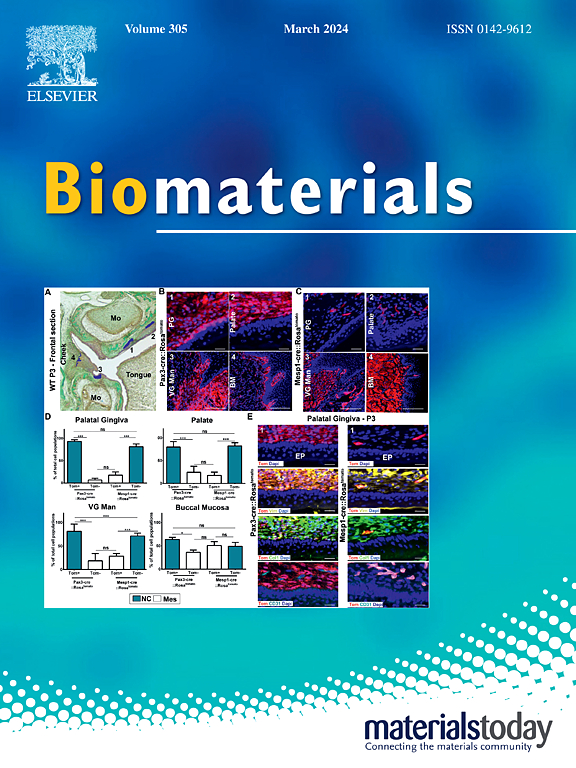ROS-triggered biomimetic hydrogel soft scaffold for ischemic stroke repair
IF 12.8
1区 医学
Q1 ENGINEERING, BIOMEDICAL
引用次数: 0
Abstract
Millions of individuals worldwide suffer from ischemic stroke (IS). The focal hypo-perfused brain brings about hostile pathological environment, which further restricts endogenous neurogenesis post-stroke. In this work, we report an ROS-triggered hyaluronic acid (HA) and platelet lysates (pls) composite biomimetic hydrogel soft scaffold (pls gel) encapsulating matrix metalloproteinase (MMPs)-responsive triglycerol monostearate nanoparticles loaded with docosahexaenoic acid (TGMS@DHA, TD). Pls gel was chosen to be the hydrogel matrix to mimic brain extracellular matrix (ECM) to provide physical support for cell infiltration and accelerate angiogenesis as a growth factors (GFs) box. The borate ester bonded hydrogel could respond to reactive oxygen species and relieve oxidative stress. The loaded TD nanoparticles could be enzymatically cleaved by overexpressed MMPs in cerebral infarcted site, which could improve the adverse effects triggered by overexpressed MMPs. DHA with rich unsaturated bonds was proven that not only inhibit neuroinflammatory and oxidative stress, but also take part in promote neurogenesis. In brief, the ROS-triggered hydrogel scaffold pls gel@TD created an optimized microenvironment to manipulate the survival and differentiation of neural stem cells and promote endogenous regenerative repair processes. The in vitro results exhibited the biomimetic soft scaffold eliminated oxygen-glucose deprivation-derived free radical, saved mitochondrial dysfunction, reduced neuronal apoptosis, and promoted neovascularization. In the mice focal IS model, the biomimetic hydrogel scaffold regulated pathological environment in the ischemic site and induced migration and differentiation of endogenous neural stem cells, consequently relieved neuron ischemia injury. During the long-term observation, the hydrogel improved mice neurobehavioral functions. In conclusion, the hydrogel soft scaffold pls gel@TD was demonstrated to have promising therapeutic effects on remodeling pathological environment by transforming the hostile state into a pro-regenerative one in the infarct site, consequently promoting endogenous regenerative repair processes.
ros触发的仿生水凝胶软支架用于缺血性脑卒中修复
全世界有数百万人患有缺血性中风(IS)。局灶性低灌注脑带来不良病理环境,进一步限制脑卒中后内源性神经发生。在这项工作中,我们报道了一种ros触发的透明质酸(HA)和血小板裂解物(pls)复合仿生水凝胶软支架(pls凝胶)包裹基质金属蛋白酶(MMPs)响应的甘油三酯单硬脂酸纳米颗粒,负载二十二碳六烯酸(TGMS@DHA, TD)。选择Pls凝胶作为水凝胶基质,模拟脑细胞外基质(ECM),作为生长因子(GFs)盒,为细胞浸润提供物理支持,加速血管生成。硼酸酯键合水凝胶能够响应活性氧,缓解氧化应激。负载的TD纳米颗粒可以被脑梗死部位过表达的MMPs酶切,从而改善过表达MMPs引发的不良反应。富含不饱和键的DHA不仅能抑制神经炎症和氧化应激,还能促进神经发生。总之,ros触发的水凝胶支架pls gel@TD创造了一个优化的微环境来操纵神经干细胞的存活和分化,促进内源性再生修复过程。体外实验结果显示,仿生软支架可消除氧葡萄糖剥夺性自由基,挽救线粒体功能障碍,减少神经元凋亡,促进新生血管形成。在小鼠局灶性IS模型中,仿生水凝胶支架调节缺血部位的病理环境,诱导内源性神经干细胞的迁移和分化,从而减轻神经元缺血损伤。在长期观察中,水凝胶改善了小鼠的神经行为功能。总之,水凝胶软支架pls gel@TD通过将梗死部位的敌对状态转化为促再生状态,从而促进内源性再生修复过程,在重塑病理环境方面具有良好的治疗效果。
本文章由计算机程序翻译,如有差异,请以英文原文为准。
求助全文
约1分钟内获得全文
求助全文
来源期刊

Biomaterials
工程技术-材料科学:生物材料
CiteScore
26.00
自引率
2.90%
发文量
565
审稿时长
46 days
期刊介绍:
Biomaterials is an international journal covering the science and clinical application of biomaterials. A biomaterial is now defined as a substance that has been engineered to take a form which, alone or as part of a complex system, is used to direct, by control of interactions with components of living systems, the course of any therapeutic or diagnostic procedure. It is the aim of the journal to provide a peer-reviewed forum for the publication of original papers and authoritative review and opinion papers dealing with the most important issues facing the use of biomaterials in clinical practice. The scope of the journal covers the wide range of physical, biological and chemical sciences that underpin the design of biomaterials and the clinical disciplines in which they are used. These sciences include polymer synthesis and characterization, drug and gene vector design, the biology of the host response, immunology and toxicology and self assembly at the nanoscale. Clinical applications include the therapies of medical technology and regenerative medicine in all clinical disciplines, and diagnostic systems that reply on innovative contrast and sensing agents. The journal is relevant to areas such as cancer diagnosis and therapy, implantable devices, drug delivery systems, gene vectors, bionanotechnology and tissue engineering.
 求助内容:
求助内容: 应助结果提醒方式:
应助结果提醒方式:


